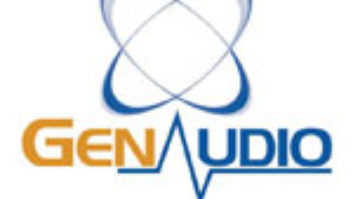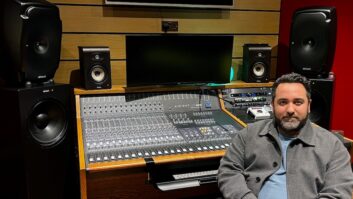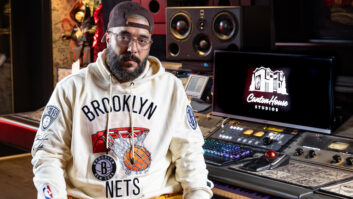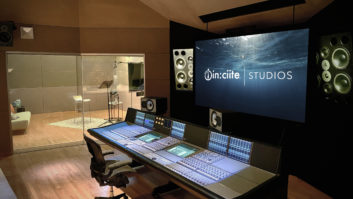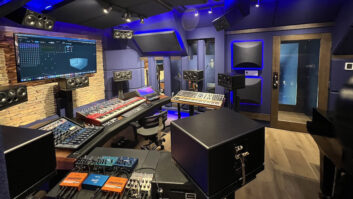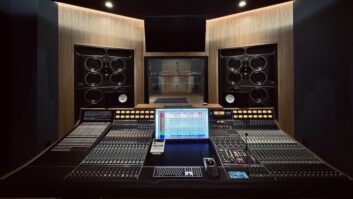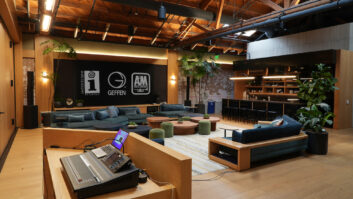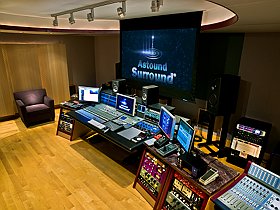
The control room is centered on an SSL C300 HD console, flanked by a PMC IB2S 5.1 monitoring system.
Photos: Jeffrey Reed

Chief engineer Greg Morgenstein (left) and owner/executive manager Jerry Mahabub

One of the Russ Berger–designed rooms inside the studio
Tucked into a small building on the Westside of Los Angeles, Astound Studios is the brainchild of GenAudio chairman and CEO Jerry Mahabub. The room is designed for critical listening to surround from 5.1 sources, as well as 2-channel surround mixes created using the company’s AstoundSound® process. The room is run by a small team of mixers, including chief engineer Greg Morgenstein, and senior re-recording engineers Andy Hay and Matt Marrin.
Gear includes an SSL C300 HD console, and converters from Lynx, Avid, Apogee, RME and JCF tube D/As. A PMC IB2S 5.1 monitor system is powered by Ayre amps, two 18-inch Bag End subs, two ADAM A-7s, two ATC SCM20SLs and more. The AstoundSound process was recently used to mix Discover the Gift in full-blown AstoundSurround, which debuted at the 2011 Sundance Film Festival. It was also used in Monster Music’s special release of the Daft Punk Tron Legacy soundtrack. Mix recently caught up with Mahabub.
How did you come up with AstoundSound?
While working in R&D for a magnetic resonance-imaging laboratory in 1988—while I was attending RPI in Troy, N.Y.—I started to notice brain-imaging patterns that would light up in response to spatial auditory stimuli. This led into taking over 7,000 functional magnetic resonance-imaging brain scans and collecting EEG/MEG data. The coupling of image data from MRI and electrical data from EEG/MEG is what enabled the core of the AstoundSound technology to be born. In 2003, I began working on the first patent, which was filed in May 2004, and I formed GenAudio immediately afterward.
The AstoundSound process is gaining traction. Tell us how you got here.
The industry has been moving toward adding more speakers to create a better spatial audio experience for the listener, especially for theatrical releases, given the explosion of 3-D film releases and other 3-D content. We focused on a solution that would make sense for the consumer and the theater chains. The vision I had in 2004 was to create a software-based approach to enable any theater to have significantly enhanced spatial audio presentation. It had to be an encode-only software process that would work with all existing delivery formats. We started off by launching a stand-alone version of the software for pro audio engineers to beta test back in October 2007 during the AES event in New York City. To that point, people like Neil Dorfsman, Hal Winer, Don Garbutt, Gus Skinas and Mick Guzauski, among many others, helped out tremendously to determine how the software should behave and with what features.
Tell us about the studio on the cover.
In 2008, I met Greg Morgenstein, currently GenAudio’s senior VP of audio engineering and Astound Studios chief engineer. I extended a full-time offer to Greg, and shortly after I took over the studio build-out. I called Russ [Berger of Russ Berger Design Group] and immediately retained him and his staff to start working on the project.
What’s next for GenAudio and AstoundSound?
We are expanding the studio facility that will include a larger dub stage for final theatrical mixing. GenAudio has also developed a CE integration version of the software that is a stereo-in/stereo-out or 5.1-in/stereo-out process. It creates the most immersive audio experience while staying in phase, and with minimal to negligible tonal colorization and no compromise to center-channel imaging or low-end information. We are working with several large CE companies that are interested in embedding our real-time software process into their CE product offerings.
